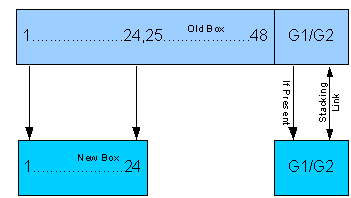 System Description
System DescriptionDell™ PowerConnect™ 3324/3348 User's Guide
 PowerConnect 3324/3348 Stacking Overview
PowerConnect 3324/3348 Stacking Overview
 PowerConnect User Guide Overview
PowerConnect User Guide Overview
 PowerConnect 3324/3348 CLI Documentation
PowerConnect 3324/3348 CLI Documentation
The Dell™ PowerConnect™ 3324 and 3348 devices are standalone and stackable advanced Layer 2 switches. PowerConnect 3324 and PowerConnect 3348 also function as stand-alone Layer 2 switching systems. PowerConnect 3324/3348 devices are managed either using In-Band Management (via the network station remotely) or via the console.

When operating as a stack member, each PowerConnect 3324 unit provides 24 10 BaseT/100BaseTX Fast Ethernet ports, one Gigabit Ethernet Combo port (10/100/1000 BaseT or Mini GBIC connector), and one Giga Ethernet stacking port.

When operating as a stack member, each PowerConnect 3348 unit provides 48 10 BaseT/100BaseTX Fast Ethernet ports, one Gigabit Ethernet Combo port (10/100/1000 BaseT or Mini GBIC connector), and one Giga Ethernet stacking port.
When operating as a stand-alone unit, the PowerConnect 3324/3348 stacking ports can be used as Giga Ethernet ports.
PowerConnect 3324/3348 stacking provides multiple device management through a single point as if all stack members are a single unit. All members are accessed through a single IP address for SNMP management and a console/telnet session through which the entire stack is managed.
PowerConnect 3324/3348 supports stacking up to six units per stack or scale up to 192 FE and six Gigabit Ethernet ports. PowerConnect 3324/3348 can also operate as standalone units.
During the stacking setup, one device is selected by the network administrator as the stack master, while all other devices are selected as stack members and assigned a unique Unit ID.
PowerConnect 3324/3348 stacks provide across-the-stack Layer 2 functionality including:
For example, VLANs can be configured from ports belonging to different stack members, or configure port mirroring from a second stack member to a third stack member. Applications running in a stacking configuration are centralized. For example, the Spanning Tree Protocol for the entire stack runs on the master unit. Device software is downloaded separately for each stack member.
PowerConnect 3324/3348 stacking architecture provides dynamic learning for the stacking topology, while detecting and reconfiguring the ports with minimal operational impact in the event of:
The stacking operation mode is determined during the Boot process.
PowerConnect 3324/3348 units are shipped with a default Unit ID of one. The Unit ID is essential to the stacking configuration. If a stack member reboots without a stacking module, the device operates as a stand-alone until the device is reset. If a PowerConnect 3324/3348 unit is operating as a stand-alone unit, all stacking LEDs are off. The Unit ID is not erased and remains valid if the unit is reconnected to a stack.
 |
NOTE: The stacking module must be inserted into port G2 for the stack to operate. If the stacking module is inserted in port G1, a warning message is displayed on the console. |
When the master unit boots or when inserting or removing a stack member, the master unit initiates a stacking discover process. If two members are discovered with the same Unit ID, or a master unit is not found, the entire stack cannot function. The stacking LED remains red.
In a PowerConnect 3324/3348 operative stack, the stack master is responsible for the stack configuration. Each stack member does not have a separate configuration file. Each port in the stack has a specific Unit ID/port type and port number, which is part of both the configuration commands and the configuration files. Configuration files are managed only from the PowerConnect 3324/3348 stack master, including:
 |
NOTE: Stack configuration for all configured ports is saved, even if the stack is reset and/or the ports are no longer present. |
Configuration files are changed only through explicit user configuration. In addition, Configuration files are not automatically modified when:
Each time the system reboots, the stored configuration is written in the Startup Configuration file.
If a PowerConnect 3324/3348 stack member is removed from the stack, and then replaced with the same Unit ID, the stack member is configured with the original device configuration.
Only ports that are physically present are displayed in the Dell OpenManage™ Switch Administrator and can be configured through the web management system. Non-present ports are configured through the CLI or SNMP interfaces.
The stacking order can be changed by either removing a stack member or by rearranging the stacking cables. The order in which stack members are arranged is established not by the physical order of the stack members but by the Unit ID assignment. The stack configuration is stored in stack master after the stack order is changed, and the stack is reset.
If the PowerConnect 3324/3348 unit is removed or replaced in a stack, the stack recovers from the disconnection as follows:
If a stack member is replaced with a new device, the requested device ID is selected. In addition, the previous device configuration is applied to the inserted stack member. If the new inserted device has either more or fewer ports than the previous device, the relevant port configuration is applied to the new stack member. For example:

PowerConnect 3324 Replaces PowerConnect 3348

PowerConnect 3348 Replace PowerConnect 3324
The PowerConnect User Guide is divided into two parts:
This section contains the following sections about unpacking, installing, and configuring the PowerConnect 3324/3348:
This section contains the following information about configuring the device using the web management system and Command Line Interface (CLI) device management system:
In addition to the PowerConnect 3324/3348 User Guide, Dell provides the PowerConnect 3324/3348 CLI Reference Guide. The PowerConnect 3324/3348 CLI Reference Guide provides information about the CLI commands used to configure the PowerConnect 3324/3348.